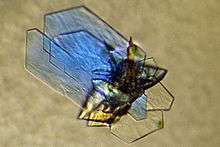Deoxyribonuclease
A deoxyribonuclease (DNase, for short) is an enzyme that catalyzes the hydrolytic cleavage of phosphodiester linkages in the DNA backbone, thus degrading DNA. Deoxyribonucleases are one type of nuclease, a generic term for enzymes capable of hydrolyzing phosphodiester bonds that link nucleotides. A wide variety of deoxyribonucleases are known, which differ in their substrate specificities, chemical mechanisms, and biological functions.

Modes of action
Some DNases cut, or "cleave", only residues at the ends of DNA molecules (exodeoxyribonucleases, a type of exonuclease). Others cleave anywhere along the chain (endodeoxyribonucleases, a subset of endonucleases).[1]
Some are fairly indiscriminate about the DNA sequence at which they cut, while others, including restriction enzymes, are very sequence-specific.
Some cleave only double-stranded DNA; others are specific for single-stranded molecules; and still others are active toward both.
DNase enzymes can be inhaled using a nebuliser by cystic fibrosis sufferers. DNase enzymes help because white blood cells accumulate in the mucus, and, when they break down, they release DNA, which adds to the 'stickiness' of the mucus. DNase enzymes break down the DNA, and the mucus is much easier to clear from the lungs.
Uses
Intrapleural tissue plasminogen activator (tPA) combined with deoxyribonuclease has been shown to increase pleural drainage, decrease hospital length of stay, and decrease need for surgery in parapneumonic effusions and empyema.
One studied protocol used a dose of DNase (Pulmozyme, Roche) of 5 mg, and a dose of t-PA (Actilyse, Boehringer Ingelheim) of 10 mg. Intrapleural medications are each given twice daily for 3 days, and each administration was followed by clamping of the drain to permit the drug to remain in the pleural space for 1 hour. Treatment with DNase alone or t-PA alone was ineffective.[2]
DNase is commonly used when purifying proteins that are extracted from prokaryotic organisms. Protein extraction often involves degradation of the cell wall. It is common for the degraded and fragile cell wall to be accidentally lysed, releasing unwanted DNA and the desired proteins. The resulting DNA-protein extract is highly viscous and difficult to purify, in which case DNase is added.[3] The DNA is hydrolyzed but the proteins are unaffected and the extract can undergo further purification.
Types
The two main types of DNase found in metazoans are known as deoxyribonuclease I and deoxyribonuclease II.
Other types of DNase include micrococcal nuclease.
Assay
DNA absorbs UV light with a wavelength of maximal absorbance near 260 nm. This absorption is due to the pi electrons in the aromatic bases of the DNA. In dsDNA, or even regions of RNA where double-stranded structure occurs, the bases are stacked parallel to each other, and the overlap of the base molecular orbitals leads to a decrease in absorbance of UV light. This phenomenon is called the hypochromic effect. When DNAse liberates nucleotides from dsDNA, the bases are no longer stacked as they are in dsDNA, so that orbital overlap is minimized and UV absorbance increases. This increase in absorbance underlies the basis of Kunitz unit of DNAse activity. One Kunitz unit is defined as the amount of enzyme added to 1 mg/ml salmon sperm DNA that causes an increase in absorbance of 0.001 per minute at the wavelength of 260 nm when acting upon highly polymerized DNA at 25 °C in a 0.1 M NaOAc (pH 5.0) buffer. The unit's name recognizes the Russian-American biochemist M. Kunitz, who proposed the standard test in 1946.
A standard enzyme preparation should be run in parallel with an unknown because standardization of DNA preparations and their degree of polymerization in solution is not possible.
Notes and references
- R. A. Bowen; Laura Austgen; Melissa Rouge (20 February 2000). "Restriction Endonucleases and DNA Modifying Enzymes". Nucleases: DNase and RNase. Biotechnology and Genetic Engineering. Archived from the original on 5 August 2004. Retrieved 8 January 2017.
- Rahman, Najib (August 11, 2011). "Intrapleural Use of Tissue Plasminogen Activator and DNase in Pleural Infection". The New England Journal of Medicine. 365 (365): 518–526. doi:10.1056/NEJMoa1012740. PMID 21830966.
- Ninfa, Ballou, Benore (2010). Fundamental Laboratory Approaches for Biochemistry and Biotechnology 2nd Edition. United States of America: John Wiley & Sons, Inc. p. 234. ISBN 978-0470087664.CS1 maint: multiple names: authors list (link)